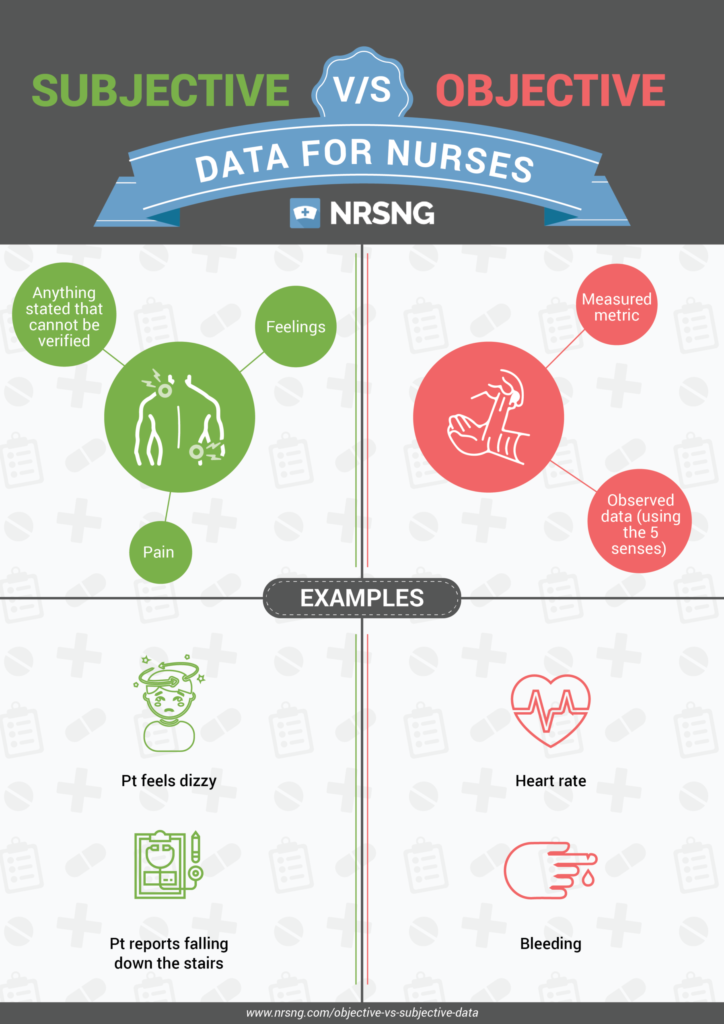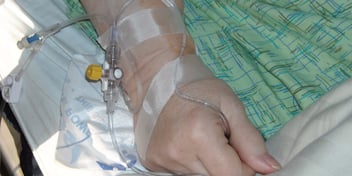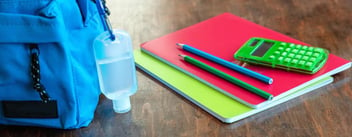Objective Vs. Subjective Data: How to tell the difference in Nursing | NURSING.com

The difference between objective and subjective data seems simple at first… but then once you dive into a nursing case study, you find yourself second-guessing what you thought was simple.
The truth is it is simple; we just make it complicated by overthinking everything.
Objective Data
This is the information that we can gather using our 5 senses. It is either a measurement or an observation.
Temperature is a perfect example of objective data. The temperature of a person can be gathered using a thermometer.
Other examples of objective data:
- Heart rate
- Blood pressure
- Respirations
- Wound appearance
- Ambulation description.
Subjective Data
This is where we all get ourselves into trouble.
Subjective data is gathered from the patient telling you something that you cannot use your five senses to measure.
If a patient tells you they have had diarrhea for the past two days, that is subjective, you cannot know that information any other way besides being told that is what happened.
Pain is subjective because the patient is telling you what their pain is.
I would get so caught up in thinking about the pain scale and whether it makes it objective because someone else can walk into the room and ask the patient to rate their pain and get the same answer, thus repeatable and measurable.
Do not let yourself get caught in this overthinking process! Simplify. What is the best NCLEX prep program?
Ask yourself, did the patient tell me this information or can I measure or observe this information by myself?
- Is this something I can observe using my five senses?
- Has the patient told me this information and can I verify it?

Breaking down and simplifying the information you are given is such a huge part of critical thinking. To help with this process we have created a great webinar to help with analyzing data and test-taking. You can check it out here
RELATED ARTICLE: 2 Examples of How I Used Critical Thinking to Care
for my Patient (real life nursing stories)
Objective vs. Subjective Examples
Let’s weed through some situations and separate the information into subjective and objective categories:
Situation:
You have a 48-year-old male patient who comes in stating, “I feel like I can’t breathe.” Patients’ respirations are 28 breaths per minute and their heart rate is 115 beats per minute. The patient then grabs his chest and says, “My chest hurts so bad, please help!” You ask the patient to rate the pain on a scale from 0-10, 10 being the worst pain ever. The patient replies, “10, it hurts so badly!” You then ask the patient to describe what the pain feels like, the patient reports that his pain feels like pressure. Your patient then starts to become diaphoretic and pale. You take an EKG that shows Sinus Tachycardia. The pulse oximeter shows 100% on room air and the patients’ blood pressure is 120/80 mmHg.
Let’s break this down:
- Objective data:
- 48-year-old male
- Respirations 28
- Heart rate 115
- The patient is diaphoretic and pale
- EKG showing sinus tachycardia
- Pulse ox 100% on room air
- Blood pressure 120/80 mmHg.
- Subjective data:
- The patient experiencing shortness of breath
- Chest pain is a pressure feeling and is 10/10
Why is shortness of breath subjective? Because the patient is telling you they feel this way, if the nurse noted accessory muscle use the accessory muscle use would be objective and the feeling of shortness of breath would still be subjective. The diaphoretic and pale skin condition is objective because it is a visible observation.
Situation:
A patient tells you they got their finger cut with a razor about 20 minutes ago and then shows you the cut on their finger, the cut is one inch long located on the left pinky finger about 1 centimeter deep. The patient states, “My finger is bleeding, can you get me gauze for the blood?”
Let’s break this down:
- Objective:
- 1 inch cut on the left pinky finger, 1 cm deep.
- Currently bleeding
- Subjective:
- The finger got cut by a razor
- Happened about 20 minutes ago
This example is trickier because of the way I worded it, the patient stated that their cut was bleeding, so why is it objective data? It is objective because the bleeding can be observed by the nurse and the example already informs you that the nurse looked at it.
You are becoming a pro at this. But just in case you wanted to flex your mental muscle, here are a few more examples:
Situation:
Your patient is holding their stomach and moaning. They say, “I can’t take this pain anymore! It feels like someone is cutting my belly with a jagged hot knife!” The patient’s face is red and sweaty, their heart rate is 115 bpm, and their respirations are shallow. The patient’s abdomen is hard, round, distended and when you percuss over each quadrant you hear dull short tones. The patient then informs you they feel dizzy. You perform an EKG and the results are normal sinus rhythm (NSR). The patient starts to cry and plead for you to help them. You reassure them that they are in the right place and you are so happy to be taking care of them. They dry their tears and thank you.
Let’s break this down:
- Objective:
- Their face is red and sweaty
- Heart rate 115 bpm
- Shallow respirations
- Abdomen hard, round, distended
- Percussed dull noises
- Patient holding abdomen and moaning
- NSR EKG
- Tearful
- Subjective:
- Burning sharp pain
- Dizziness
The description of the patients’ pain, as well as the feeling of being dizzy, is subjective data that you are not able to confirm. The patient is only able to tell you this is how they feel.
Situation:
You are walking by a patients’ room when you hear them say, “Help! I can’t breathe!” Upon entering the patient’s room you notice your patient has sat over the edge of the bed and is in the tripod position. Lips are blue, pursed and the patient is using their intercostal muscles to breathe. You notice the NC that the patient is wearing is not hooked up to an oxygen tank and quickly place your patient back on 4L. The patient tells you they were trying to go to the bathroom but were unable to make it. You help the patient to the bathroom and back to their bed, making sure their call light is within reach.
Let’s break this down:
- Objective:
- Sitting on the edge of the bed
- Tripod position
- Blue lips
- Pursed lip breathing
- Intercostal muscle usage
- Nasal Cannula not hooked up
- Subjective:
- Patient stating, “I can’t breath”
- The patient was trying to go to the bathroom
How to Study for Nursing School
Why would the patient tell you they were trying to go to the bathroom be subjective? It seems that either they were or they were not trying to go to the bathroom. You still cannot measure this using the five senses except to be told this by the patient, making it subjective.
Situation:
Your patient is 2 days post-op left knee surgery and needs to start ambulating with a walker. You untangle all their cords and IV tubing and start to walk with them down the hallway. The patient has a shuffling gait and states, “I’m afraid to put too much pressure on my left leg, I don’t want to break open my stitches.”
You comfort your patient and explain that evidence-based research shows that the sooner the patient starts to walk after surgery the better the outcome of the surgery. Your patient takes your advice and bravely starts to put more and more pressure on the left leg.
The patient walks down the hallway and back (about 30 feet)without difficulty but states, “I feel out of breath and need to sit down.” You get your patient a chair and pull over a Dynamap to check their pulse-ox.
- is 95%
- Breathing 24 breaths per minute
- Skin is pink, warm, and dry
- No accessory muscle use
- A&O times four.
The patient regains their confidence and you walk them back to their bed. The patient reports they are exhausted from the walk and would like to rest.
Let’s break this down:
- Objective:
- 2 days post-op
- Shuffling gait
- Afraid to walk on the left leg
- Ambulation for 30 feet without difficulty
- Patient Pulse-ox 95%
- RR 24 non-labored
- Skin pink, warm, dry
- A&Ox4
- Subjective:
- The patient feels out of breath
- Patient feels exhausted
I’d like to take some time to talk about this rationale. I put it in there because this is the kind of rationale I would hear in nursing school. I cannot stress this enough, do not get upset if you got this ‘wrong’. In my personal opinion, it can be argued either way and if I were the teacher who was making this question I would have put it as subjective and not objective.
The point of me putting this in here is to address that subjective and objective can sometimes be in the gray area. Nursing can sometimes be in the gray area. Don’t get caught up on the details like this and just do your best to make an educated guess. The teacher who decided the answer has their personal opinion about its’ rationale.
Guess what? Opinions are like armpits, everyone has them, and most of the time, they stink.
Conclusion
Does this make sense to you? Take a deep breath, go to the root of the information, and make it simple. You CAN Do This!
Nursing Head-to-Toes Physical Assessment Video


.png?width=50&height=50&name=image%20(11).png)



